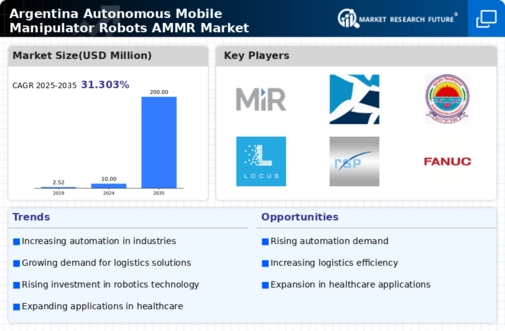Market Growth Projections
The Global Argentina Autonomous Mobile Manipulator Robots Market AMMR Market Industry is poised for substantial growth, with projections indicating a market size of 750 USD Million in 2024 and an anticipated increase to 2500 USD Million by 2035. This growth trajectory suggests a compound annual growth rate of 11.57% from 2025 to 2035, reflecting the increasing adoption of AMMRs across various sectors. The market dynamics are influenced by factors such as technological advancements, rising demand for automation, and the need to address labor shortages. These projections underscore the potential of the AMMR market in Argentina and its role in shaping the future of automation.
Increased Demand for Automation
There is a notable surge in the demand for automation across various sectors, which is significantly influencing the Global Argentina Autonomous Mobile Manipulator Robots Market AMMR Market Industry. Industries such as manufacturing, logistics, and healthcare are increasingly relying on AMMRs to streamline operations and reduce labor costs. For example, in manufacturing, AMMRs are utilized for tasks such as assembly and material handling, leading to enhanced productivity. This growing reliance on automation is expected to contribute to a compound annual growth rate of 11.57% from 2025 to 2035, indicating a robust market trajectory.
Technological Advancements in Robotics
The Global Argentina Autonomous Mobile Manipulator Robots Market AMMR Market Industry is experiencing rapid technological advancements that enhance the capabilities of these robots. Innovations in artificial intelligence, machine learning, and sensor technology are driving the development of more sophisticated AMMRs. For instance, the integration of advanced vision systems allows robots to navigate complex environments with greater precision. This trend is likely to bolster market growth, as businesses increasingly adopt these technologies to improve operational efficiency. As a result, the market is projected to reach 750 USD Million in 2024, reflecting the growing demand for intelligent automation solutions.
Labor Shortages and Workforce Challenges
The Global Argentina Autonomous Mobile Manipulator Robots Market AMMR Market Industry is also being driven by persistent labor shortages and workforce challenges. Many sectors are facing difficulties in recruiting skilled labor, prompting companies to explore automation solutions. AMMRs offer a viable alternative, enabling businesses to maintain productivity levels despite workforce constraints. For instance, in the logistics sector, AMMRs are deployed to assist with inventory management and order fulfillment, mitigating the impact of labor shortages. This trend is likely to sustain market growth, as organizations seek to optimize their operations through automation.
Expansion of E-commerce and Logistics Sectors
The expansion of e-commerce and logistics sectors is significantly impacting the Global Argentina Autonomous Mobile Manipulator Robots Market AMMR Market Industry. As online shopping continues to grow, there is an increasing need for efficient warehousing and distribution solutions. AMMRs are being deployed to automate tasks such as sorting, packing, and transporting goods within warehouses. This trend not only enhances operational efficiency but also improves order accuracy and delivery times. The rising demand for such automation solutions is likely to further stimulate market growth, positioning AMMRs as essential tools in the evolving logistics landscape.
Growing Investment in Research and Development
Investment in research and development is a critical driver for the Global Argentina Autonomous Mobile Manipulator Robots Market AMMR Market Industry. Governments and private entities are increasingly allocating resources to advance robotics technology, fostering innovation and enhancing the capabilities of AMMRs. For example, Argentina's government has initiated programs to support robotics research, which is expected to yield new applications and improvements in AMMR functionality. This focus on R&D is anticipated to propel the market forward, with projections indicating a market size of 2500 USD Million by 2035, reflecting the long-term potential of the industry.





















Leave a Comment